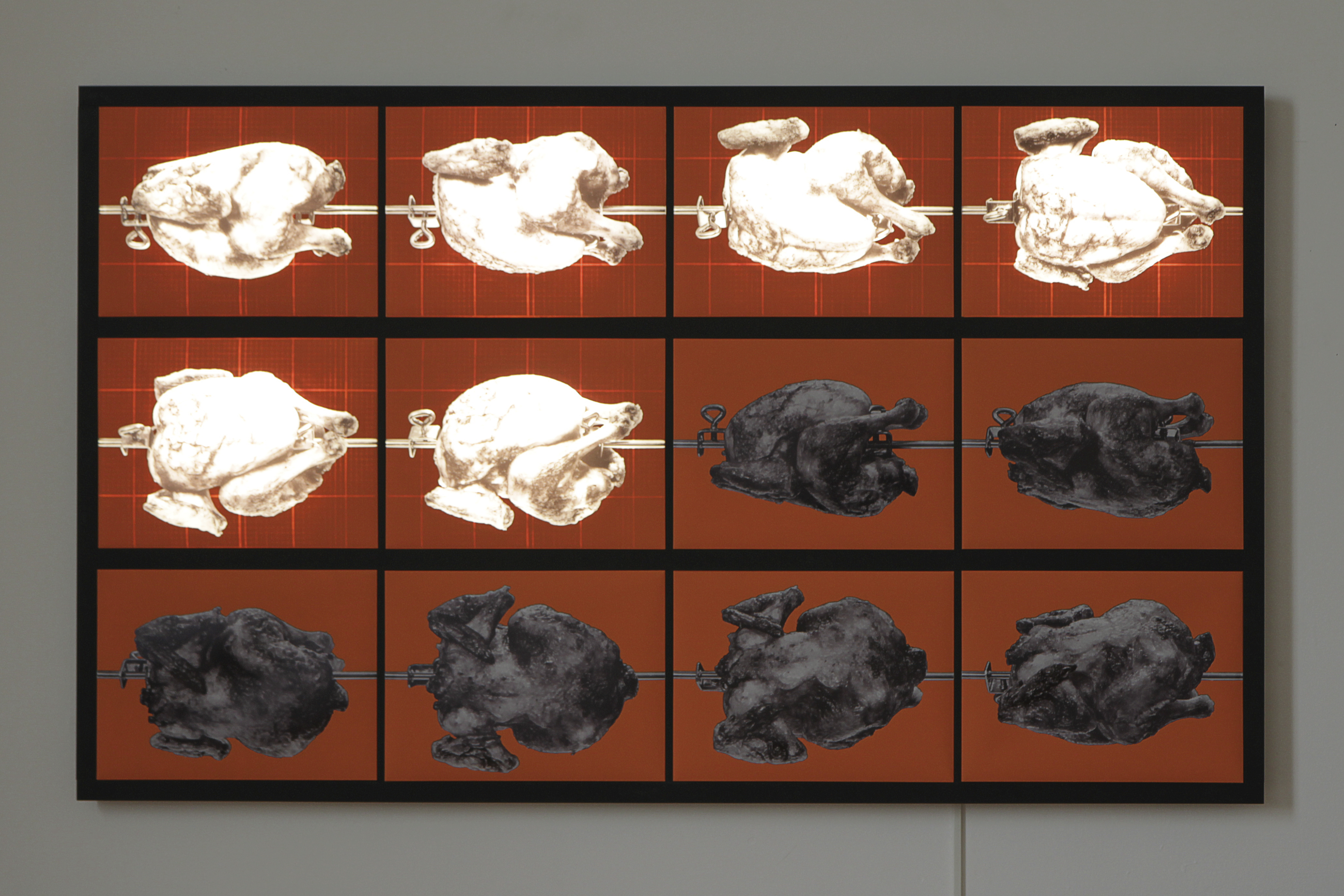Grilled Chicken, 2014
Inkjet printing on backlit film and transparent paper, oil paint, black MDF board, electronics with LEDs, 122 x 203 cm
This
work consists of a black and white photo series of a grilled chicken spiked on a
barbecue skewer, which was rotated horizontally once around its own axis by 30°
each time. The grill skewer as a connecting element makes it possible to
imagine twelve different grilled chickens in three grill skewer rows in a grill
device.
Photography
Both the chosen camera perspective in normal view and the number of photos
and their arrangement in a grid are based on the movement studies by Eadweard
Muybridge from around 1880. Originally, these motion studies were made for
scientific purposes. Accordingly, they can be viewed without emotion.
The oil paint applied to the backlit film fulfills two functions: it
creates stencils so that the grilled chicken is brightly lit while the
background darkens and the chosen coloring underlines the proletarian
characteristics of the picture subject. The color alludes to the oranges which
can be found in waste management (MA48), in hardware stores (OBI, Hornbach) or
as rust protection paint. In addition, the potentially nationalistic aspect of
the grilled chicken (as a traditional dish at beer tent festivals) can also be
noted.
With the help of programmed control and built-in LEDs, each image can be
illuminated one after the other with specific time intervals. In order to be
able to follow
Photography
Both the chosen camera perspective in normal view and the number of photos
and their arrangement in a grid are based on the movement studies by Eadweard
Muybridge from around 1880. Originally, these motion studies were made for
scientific purposes. Accordingly, they can be viewed without emotion.
Colour
Movement sequence
Lighting
Due to the materiality of the light and the increased light-dark contrast,
the photos of the grilled chicken appear more three-dimensional than usual.
This effect is created by adding an additional black and white print on
transparent paper on the back of the backlit film so that the shadows of the
grilled chicken stay dark when it is lit. As the brightness increases
continuously up to the twelfth lightbox, the viewer's eyes are imperceptibly
overexposed, so that the abrupt shutdown of the LED’s causes a brief visual
disturbance.
Sense of sight of the chicken
Chickens can perceive a larger spectrum of light (RGB + UV light and
shimmering colors) and the resolution of their eyes, at up to 160 Hertz, is
significantly higher than that of humans. As a result, when chickens are in an
environment with a conventional AC fluorescent tube or incandescent lamp, they
are exposed to continuous stroboscopic flickering. In addition, without the
lighting of the UV spectrum the chickens are forced to perceive their world in
complementary colors.Many thanks to YeLa An, Helmut Habel and Thomas Steineder for their helpful advice and support.




 exhibition view, Rundgang 2015, Academy of Fine Arts Vienna
exhibition view, Rundgang 2015, Academy of Fine Arts Vienna
photos: Thomas Steineder, Matthias Kendler
© 2025 Matthias Kendler